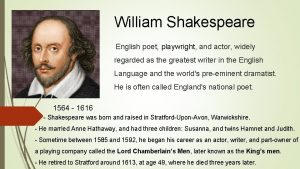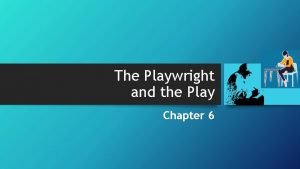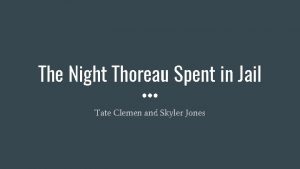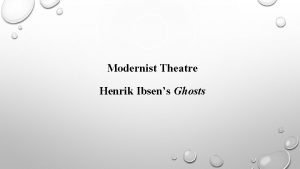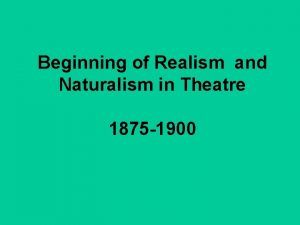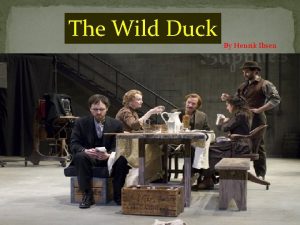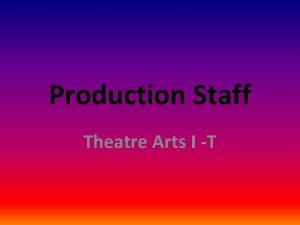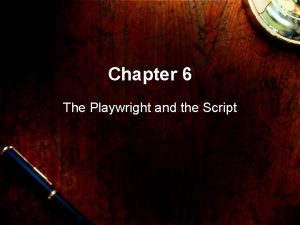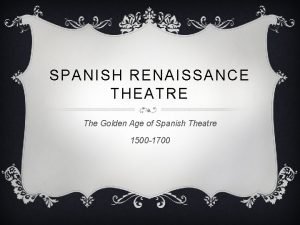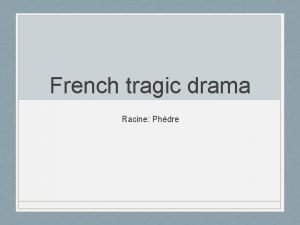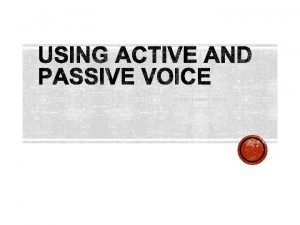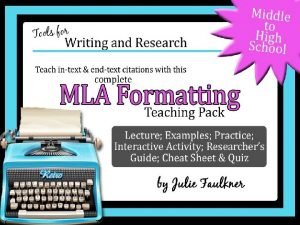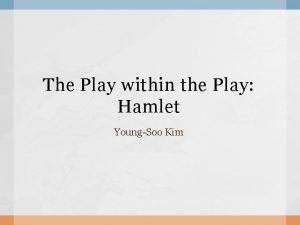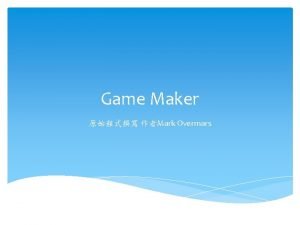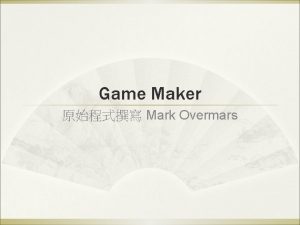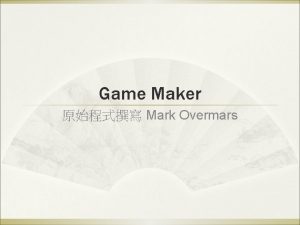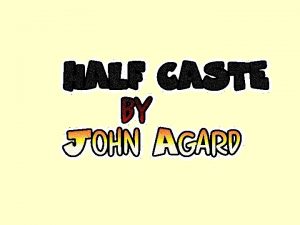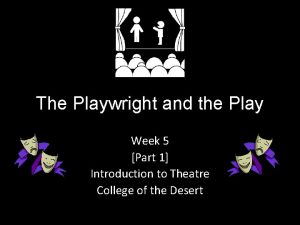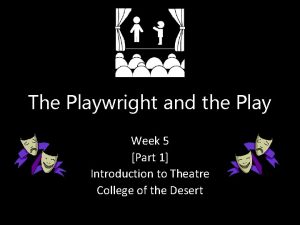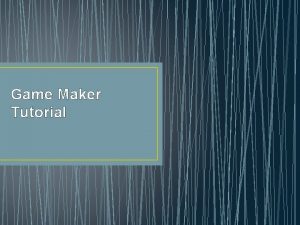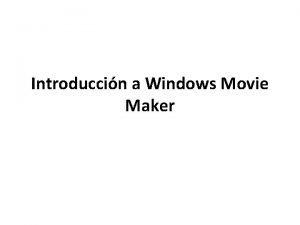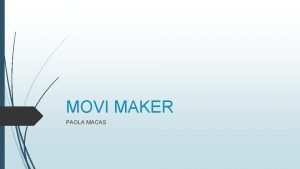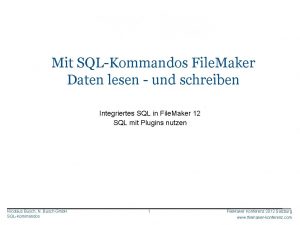Chapter 4 Image Maker The Playwright A play



















- Slides: 19

Chapter 4 – Image Maker: The Playwright A play in a book is only the shadow of a play and not even a clear shadow of it. . [It] is hardly more than an architect’s blueprint of a house not yet built or built and destroyed. —Tennessee Williams

Chapter Summary • The playwright envisions the play’s world, its people, words environment, objects, relationships, emotions, attitudes, and events: – Playwright = “play builder” • Playwriting is a creative act that enlarges our understanding of human experience. • Playwriting enriches our appreciation of life.

The Play and the Audience • Experience of watching a play divided: – Emotional involvement – Aesthetic detachment • Empathy for characters draws us into world of play. • Awareness that it’s a play keeps us at a distance. • Catharsis: – A cleansing or purging of strong emotions. – Empathy for fictional characters inspires emotions such as pity and fear, but at a comfortable distance.

The Play and the Audience • Most playwrights encourage empathy in audience for characters: – An exception: Bertolt Brecht • Alienation effect (Verfemdung) • Distance encourages judgments about social and economic issues in play

The Play: “A Blueprint for a House Not Yet Built” • Playwright: – Writes a play to express some aspect of human experience – Shapes a personal vision into an organized, meaningful whole • Script: – Blueprint for a specific dramatic experience • Play attains finished form only in performance.

The Playwright’s Beginnings • Modes of playwriting: – Start with idea, dream, and/or image, then work out an action to express it – Start with character or real person then develop action around him or her – Start with a situation, then let it unfold • No two playwrights use the same approach

The Playwright’s Beginnings • Examples: – Bertolt Brecht: • Started with outline, then summarized social and political ideas before building a story based on the outline – Sam Shepard: • Handwrites draft, then works out revisions in theatre before writing final draft

The Playwright’s Role: Production • Once script is written, playwright takes a backseat to director, designers, actors, producers. • Exceptions: – Playwrights who direct (e. g. , David Mamet) – Playwrights who act/produce (e. g. , Shakespeare) • Playwright may contribute to production through script revisions.

The Playwright’s Tools • Playwright’s “toolbox”: – Plot: What happens in a play – Character: The people in a play – Language: What the characters say (dialogue) • Conflict: – Clash of personal, moral, or social forces – Plot works toward resolution of central conflict

The Playwright’s Tools • Plot and performability: – Powerful and sustained dramatic impact – Compression: • Play unfolds faster than real time. – Economy: • Whatever does not contribute to the overall effect is omitted. – Intensity: • Emotional intensity holds audience’s attention.

The Playwright’s Tools • Characters must be: – Believable – Multifaceted – Complex My chief aim in playwriting is the creation of character. . [My] plays have been an effort to explore the beauty and meaning in the confusion of living. —Tennessee Williams

The Playwright’s Tools • Dialogue: – Must be speakable – Must contain potential for gesture and meaning

The Playwright’s Industry • Literary agencies: – International Creative Management (ICM) – William Morris Agency • Essential connections: – Agent – Producer – Director

New American Writing: Alternative Voices • Late 1980 s saw emergence of playwrights representing underrepresented minorities: – Gay and lesbian – African American – Latino/a

New American Writing: Alternative Voices • Gay and lesbian writing: – Mart Crowley, Boys in the Band • Introduced sexual orientation as acceptable subject • Important works: – Bent, Martin Sherman – The Normal Heart, Larry Kramer – Angels in America, Tony Kushner – How I Learned to Drive, Paula Vogel

New American Writing: Alternative Voices • African American writing: – Early works: • Mulatto, Langston Hughes (1930) • A Raisin in the Sun, Lorraine Hansberry (1959) • Important works: – Slave Ship, Amiri Baraka (Le. Roi Jones) – Ma Raney’s Black Bottom, August Wilson – The America Play, Suzan-Lori Parks – for colored girls who have considered suicide/when the rainbow is enuf, Ntozake Shange

New American Writing: Alternative Voices • Asian American writing: – Early works pushed back against stereotypes • Important works: – Sisters Matsumoto, Philip Kan Gotanda – L. A. Stories, Han Ong – Stop Kiss, Diana Son – M. Butterfly, David Henry Hwang

New American Writing: Alternative Voices • U. S. Latino/a writing: – North American Spanish-speaking theatre in existence since late 1500 s – Modern era: Luis Valdez and El Teatro Campesino (The Farm Workers’ Theatre) • Important works: – Anna in the Tropics, Nilo Cruz – The Conduct of Life, María Irene Fornés – The Floating Island Plays, Eduardo Machado – Roosters, Milcha Sanchez-Scott

Core Concepts • When theatrical process starts with script, playwright is most essential artist in a production • Playwright builds the world of the play: – Events – Characters – Meaning • Playwright hands finished script to director, actors, designers
 Windows live movie maker transitions
Windows live movie maker transitions William shakespeare english poets
William shakespeare english poets Verse drama
Verse drama Ancient greek theater masks
Ancient greek theater masks Playwright template
Playwright template Robert e. lee (playwright)
Robert e. lee (playwright) Ghosts by henrik ibsen
Ghosts by henrik ibsen Realism vs naturalism in theatre
Realism vs naturalism in theatre English poet and playwright
English poet and playwright The wild duck themes
The wild duck themes Production staff
Production staff Irish playwright wilde
Irish playwright wilde Playwright vs playwrite
Playwright vs playwrite What spanish playwright wrote over 700 plays
What spanish playwright wrote over 700 plays Oedipus rex playwright
Oedipus rex playwright Phedre playwright
Phedre playwright I've got a friend we like to play we play together
I've got a friend we like to play we play together Louise made the chocolate cake active or passive
Louise made the chocolate cake active or passive Typewriter types
Typewriter types Hamlet kim
Hamlet kim

